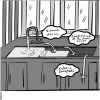Oxidative stress and food as medicine
- PMID: 39262430
- PMCID: PMC11387802
- DOI: 10.3389/fnut.2024.1394632
Oxidative stress and food as medicine
Abstract
There has been a sea of change in our understanding of the contribution of food to both our well-being and disease states. When one addresses "food as medicine," the concept of oxidative stress needs to be included. This review interconnects the basic science findings of oxidative stress and redox balance with the medicinal use of food, emphasizing optimization of the redox balance. To better illustrate the impacts of oxidative stress, the concept of the "triple oxidant sink" is introduced as a theoretical gauge of redox balance. Utilizing the concept, the true importance of dietary and lifestyle factors can be emphasized, including the limitations of supplements or a handful of "superfoods," if the remainder of the factors are pro-oxidant. The effects of a whole plant food diet compared with those of dietary supplements, processed foods, animal based nutrients, or additional lifestyle factors can be visually demonstrated with this concept. This paper provides an overview of the process, acknowledging that food is not the only mechanism for balancing the redox status, but one that can be strategically used to dramatically improve the oxidative state, and thus should be used as medicine.
Keywords: antioxidant lifestyle; antioxidants; oxidative stress; pro-oxidants; processed foods; redox balance; triple oxidant sink; whole food antioxidants.
Copyright © 2024 Carlson, True and Wilson.
Conflict of interest statement
The authors declare that the research was conducted in the absence of any commercial or financial relationships that could be construed as a potential conflict of interest. The author(s) declared that they were an editorial board member of Frontiers, at the time of submission. This had no impact on the peer review process and the final decision.
Figures
References
-
- NCI Dictionary of Cancer Terms-NCI (2011). Definition of oxidative stress. Available at: https://www.cancer.gov/publications/dictionaries/cancer-terms/def/oxidat... (Accessed July 19, 2023).
Publication types
LinkOut - more resources
Full Text Sources


